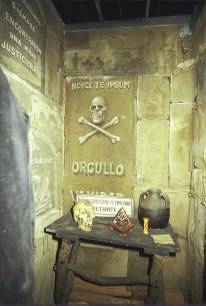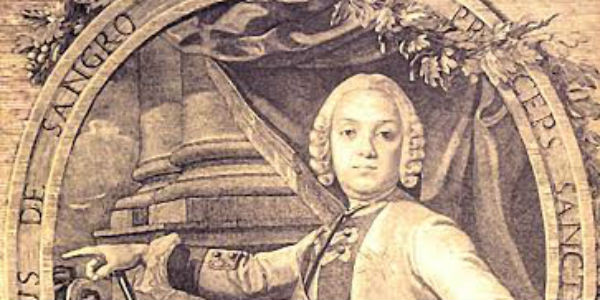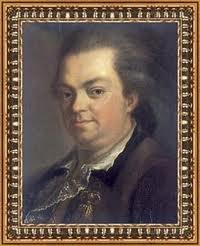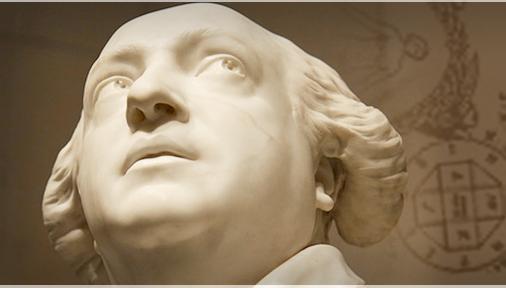In 1737[1] at the Grand Lodge of France in Paris its Grand Orator the Chevalier Ramsay , enunciated that the Masonic Order descended from the Knights Templar and was therefore of an exclusively aristocratic nature. Soon after that speech, numerous Masonic High Degrees were founded all over Europe, each one of them claiming to be the rightful guardians of some superior secrets that came in the form of privileged expression of Spiritualism or Esoterism.
The Egyptian Masonic Order was one of those Higher Degrees and it was founded in France by the self-styled Count Alessandro Cagliostro, akas Giuseppe Balsamo[2] from Palermo, who has remained one of the most enigmatic characters in history. Considered to be a great magician, alchemist and healer in some circles or a rogue and a charlatan in others, Cagliostro was accused to be part of the famous plot of “L’affaire du collier de la Reine “(Marie Antoinette)[3] in 1785 at the Court of King Louis XVI. After years of drifting in Europe, the Count ultimately died in 1795 in the gaols of the fortress of San Leo[4] having been sentenced to life imprisonment by the Church Inquisition. Yet with the foundation of the High Degree of The Egyptian Freemasonry, Cagliostro had created something in life that, at least for a while, gave him fame and respect although later it will also cause his downfall and imprisonment.
Cagliostro had joined the London Lodge “Esperance” on 12th April 1777. However the speed with which he reached the highest degree when he was in England suggests that he had already been initiated elsewhere, probably in Malta in 1776. In 1784 he travelled to Lyon and took lodgings at the Hotel de la Reine . There he registered himself under the assumed name of Count Fenice [5] and asked the most illustrious Freemason in town to come and meet him. That individual was Jean-Baptiste Willermoz , who later wrote: “I went to see him two days after his arrival and I went there suspiciously expecting to meet a person called Count Fenice but from his mannerism I soon realised I was in front of Cagliostro. He spontaneously admitted his real identity and told me that he had renounced the practice of medicine – which made enemies for him wherever he went – and now wanted to occupy himself exclusively into instructing selected Freemasons to the truest Freemasonry of all , that of the Egyptian Rite which teaches to work for the glory of God and the happiness of mankind “.
THE EGYPTIAN ORDER
Those regular meetings between the two Freemasons came to an end after only eight days. Willermoz wrote: “I have held four private meetings with the Count and in the last one we mighty quarrelled for the diversity of our principles (…) I argued with him most strongly and then left the room. I never wish to see him again”. Nevertheless a Mother Lodge for the Egyptian Rite – called “The Triumphant Wisdom – was later established by the Count in Lyon , a city which at the time was seething with Freemasonry and whose Lodges had some very famous adepts like the Count of Saint-Germain , Mesmer and Louis de Saint Martin.
During the years of the French revolution and of the terror the ensued , the old Masonic lodges forgot their way. They no longer encouraged the study of Alchemy or Symbolism but spurred also by what had been achieved across the Ocean , they began to concentrate their efforts in devising plots to topple the tyrants of Europe and in politics-making rather then improving the nature of man. Cagliostro sought to fill that void with his speculative Freemasonry which inspired itself to the tradition as well as to the myths and symbols from Egypt.
The essence of this Degree is in the instructions which like in the traditional Freemasonry are still symbolic but are seen in the light of the Alchemy process . The teaching of some basic ceremonial magic from the Clavicles of Solomon – a classical genre – is also present. One of the principal characteristics of the Egyptian Rite resides in the Tablets submitted to the candidate for meditation.
In general there are two of those tablets in each Degree: one is placed inside a “chamber of reflection” before the ceremony starts whilst another is placed at the centre of the Lodge.
The Lodge includes twelve Brethren, each brother representing the twelve great prophets of Israel. It is governed by two Venerable Masters who represent the characters of Solomon and Hiram King of Tyre. Within three years the Apprentice was raised to the degree of Companion and another 5 were needed to become a Master. Every Lodge was formed by 72 Apprentices , 24 Companions and 12 Masters.
Often the name of the High Degrees was very poetic except that in their Rituals the imagination did not seem to go far enough. Even the disciples of this Order were still received with the titles of: Apprentice, Companion and Master. On the eastern side of the Lodge, communicating with it through a window, there was a little retreat called “Tabernacle” in which there was just enough space for a chair and a table on which was placed a bowl of water.
Unlike every other Masonic system , in the Egyptian Rite the candidate discovers a decorum that is also very similar to that of a traditional Lodge but has one most notable difference: the Master wears a white cassock or “talare” which gives him the air of a High Priest. In the Statutes of the Egyptian Mother Lodge “The Triumphant Wisdom” it is stated that to be admitted the candidate must have already been initiated in Freemasonry and be at least of 25 years of age. It also automatically excludes from the selection process all atheists, for they believe neither in the existence of a Supreme Being nor in the immortality of the soul.
The Egyptian ritual is based on six commandments:
Love of God
Respect for your country ruler
Observance of religion and the law
Love of your kind
Loyalty and Devotion to the Order
Total submission to the rules of the Rite
In addition the Egyptian Rite Freemasonry also had three obligations:
Tolerance
Secrecy
Respect for the Nature
Another interesting aspect of the Egyptian Rite is represented by the art of reading the future, a task performed by the Lodge’s youngest neophyte or “Pupil” who sits facing a bowl of water which acts a magic mirror . Thereafter the works of the Lodge consist in making contact , always through the “Pupil” , with the intermediary spirits who will help them reach the celestial entities and ultimately communicate with God !
THE CABINET OF MEDITATION
The manner in which the Candidate is initiated is of great interest. He is placed in a dark room under the constant supervision of a Brother who is armed with a sword. The room is called “Chamber of Reflection” or “Cabinet of Meditation” , it is all painted and furnished In black and is surrounded by funereal images (egg-timer, scythe, skeleton) that remind the candidate that his hour of death and rebirth is nigh.
The room is essentially a symbolic tomb and to make the Candidate even more conscious of the step he is about to take, he is asked to write a Spiritual Testament and divest himself of all metals; the latter gesture symbolising the constant rejection of vices by a Freemason in his life. Both are necessary steps for gaining access into the Temple and start working for our spiritual progress and that of humanity.
The Egyptian Rite gives his adept a symbolic age that varies in relation to the Degree he has reached. The max age of a Master is 5557 years, i.e. three times 5 and 7, which correspond to the ages of the 3 Apprentice 5 Companion and 7 The Master. And as every Freemason knows well : 3, 5 and 7 are numbers that also appear in the traditional Masonic Degrees.
But what made Cagliostro’s Egyptian Freemasonry Rite unique and extremely appealing especially to the Aristocracy ?
It was the promise that its adepts would be taught how to regenerate themselves both physically and mentally and so achieve immortality. The Count Alessandro Cagliostro supposedly knew and would disclose to his disciples a secret method whereby , at intervals of every 50 years, man could overcome the rules of nature and be reborn in body as well as mind. It was a dream that might perhaps explain , albeit with a pinch of cynicism, why the Higher Degrees were so popular amongst the nobility and men of wealth in general. Each process of regeneration required a period of 40 days (a “quarantine”). The mind rebirth would take place on the peak of a mountain where the neophyte had to spend forty days in contemplation and prayers that will turn him as pure as a child. The physical regeneration would occur during a similar period of 40 days spent in an alcove in the open countryside somewhere. Essentially, Cagliostro’s “quarantine” was the same “quarantine” that Moses observed on the Mount Sinai, that Jesus spent in the desert ; the same quarantine that precedes Easter (Quaresima) or the Ramadan itself.
According to what Mariano Iodice wrote in the “Nuovo Monitore Napoletano” of 15Dec2011, in the reports kept by the Sant’Uffizio[6] , Cagliostro declared that his craft came from the teaching that he received from a Neapolitan philosopher. That individual could have been either Luigi D’Aquino[7] – brother of the more illustrious and famous Francesco – or Raimondo di Sangro ,Prince of San Severo whose life has been narrated in a separate Paper published earlier by Tetraktys.
whose life has been narrated in a separate Paper published earlier by Tetraktys.
By qualifying his Rite with the adjective “Egyptian” , Cagliostro intended to underline the presence of a Rosicrucian basic idea that Freemasonry was the legitimate heir of the old mysteries. What the Count Cagliostro said when he was interrogated by the Inquisition appears to come straight from the Egyptian Books of the Dead: “I am not of any time or of any place; beyond time and space my spiritual being lives an eternal existence. I turn my thoughts back over the ages and I project my spirit toward an existence far beyond that which you perceive, I become what I choose to be. Participating consciously in the Absolute Being, I arrange my actions according to what is at hand. My name defines my actions because I am free. My country is wherever my feet stand at the moment.(…)”. It echoes Osiris’s lines from the Egyptian Book of the Dead that reads : “I am the immediate and I am the past (…)” and so forth.
CAGLIOSTRO’S DREAM OF A UNIFIED FREEMASONRY
Cagliostro realised that with so many divisions in the Freemasonry of his time , so many different Degrees and Orders in existence , so much politics and conspiracy making , something could and should be done to give the Masonic system a jolt and remove the disorder that reigned within it. He had a cunning plan which Philippe Brunet[8] analysed and Mariano Iodice reported as follows.
Cagliostro, having been informed by the counsellor of his friend – the Prince Bishop of Rohan- that a meeting was to be held by the Order of the Filateti[9] in Paris, travelled there and took lodgings at the Palais Royale. Then he proceeded with step two of the plan and appointed his Order’s counsellors – the Grand Secretary, the Grand Inspector etc. – by electing from the Aristocracy. For example the founder in 1773 of the Order of the Filateti – Baron Baudart de Saint James –was invested with the title of Grand Chancellor of the Supreme Council of the Egyptian Rite in Paris. Then Cagliostro waited for the Filateti to start squabbling amongst themselves , to start filling their minds with confusion and doubts and to ultimately turn to him for answers. At that point he would have been able to impose his conditions for a reunion of the Filateti under his own Order. When the Filateti did just as Cagliostro had predicted and came to him for advice , from his high ground of Grand Master of the Egyptian Order, Cagliostro asked them to burn all those scripts and books they kept in their archives and let rise from those ashes the “Temple of Truth”.
The Filateti, becoming suspicious that this was simply an attempt to repeat what had occurred in London in 1720 with the imposition on the Freemasons of James Andersons’ Constitution , hesitated. Cagliostro was annoyed by their stance of suspicion and thundered: “Why is the lie always on your tongue and the doubt forever in your hearts ? Only God can decide between you and I. As you prefer a bunch of books and writings to the happiness that I was ready to bestow on you; as you are faithless in God’s promises or his minister on earth , I abandon you to your destiny and I tell you in truth : to teach you is no longer my mission. Oh unhappy Filateti, you sow in vain and will only reap chaos”.
It was the end for Cagliostro’s ambitious scheme of slowly merging all the Freemasonry Orders , starting from this one, into a singular movement under the ruling of his Egyptian Order. Had he succeeded he would have realised the Chevalier Ramsay’s dream of at last reconciling the Church with Freemasonry. Instead it cast the Egyptian Order in the wilderness for a very long time and led to the debacle and early death of its founder and Grand Master : Count Alessandro Cagliostro. But in a century that gave birth to the Enlightenment , the Egyptian Rite without doubt fitted perfectly well into any of the existing models of secret society and deserves everybody’s attention.
by De La Riviere
The author forbids any reproduction or publication of this article, in full or in part, without his explicit authorisation.
[1] See the Paper “Freemasonry and Occultism” of November 2016
[2] Count Cagliostro was born Giuseppe Balsamo on June 2, 1743 in Palermo, Sicily, Italy.
[3] The Affair of the Diamond Necklace
[4] Rimini, Emilia-Romagna, Italy
[5] Note how he appropriately chose that name Fenice or Phoenix in Latin, which is a bird that was very sacred to the Egyptians
[6] Founded by Paolo III (1542) to combat the heresy and deriving from the Inquisition
[7] The Chevalier Luigi d’Aquino, of the noble Neapolitan family of Caramanico, was the younger brother of Francesco d’Aquino, Prince of Caramanico , Grand Freemason and cousin of Raimondo de Sangro, Prince of San Severo, a famous Alchemist and Gran Master of the Neapolitan Freemasonry. In 1766 Luigi d’Aquino initiated Giuseppe Balsamo, future Count Alessandro Cagliostro, into Freemasonry.
[8] Author of the book: “Cagliostro”
[9] The Order of the Filaleti or Teosofi was founded in 1773/ 1775 by a group of Freemasons from the Scottish High Degrees, who were experts in the occult sciences and in Masonic Esoterism.
- Influencia de la Masonería en Chile - April 29, 2024
- Pomegranate in Freemasonry – its significance - March 11, 2024
- Inns and Innkeepers’ incidence in Freemasonry expansion - February 28, 2024

